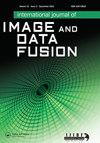综合减灾情报服务数据融合的最新进展
IF 1.8
Q3 REMOTE SENSING
International Journal of Image and Data Fusion
Pub Date : 2021-10-02
DOI:10.1080/19479832.2021.1970931
引用次数: 1
摘要
回顾过去的十年,超级风暴、野火、洪水、地质灾害和特大地震在全球造成了难以想象的损失。2020年,全国各类自然灾害受灾人数近1.38亿人,死亡失踪591人,紧急安置589万人。直接经济损失370.15亿元。随着遥感、物联网等数据采集技术的发展,灾害相关数据的采集变得快速、便捷。但是,与灾害有关的数据的获取方法各不相同,因此地理范围和分辨率也各不相同;因此,如何融合各种灾害相关数据对于应急减灾具有重要意义(Liu et al. 2020)。灾害相关数据对于了解灾害的影响和成本至关重要,数据融合在灾害预测、减灾、评估和智能服务中发挥着重要作用。使用多源数据可以提高各个层次的信息可用性和质量(Liu et al. 2018, Liu et al. 2020)。特别是在应急工作中,整合多源数据,为减灾服务提供最新、准确、及时、不同尺度的信息尤为重要。例如,2018年10月10日,川藏交界的金沙江流域发生大规模滑坡,形成堰塞湖,对下游金沙江地区人民生命财产造成极大威胁(Qiu et al. 2017, Li et al. 2020a)。利用灾害多源数据融合(Gamba 2014)、时空过程模拟(Wang et al. 2020)、可视化分析和风险评估(Li et al. 2020)以及灾害信息智能服务,生成决策信息,支持灾害应急管理(Liu et al. 2018)。本期《综合减灾情报服务数据融合》专刊重点介绍了灾情数据融合的最新理论和技术问题,旨在梳理当前的研究进展,为在这一领域相互学习和交流提供机会。本特刊由国家重点研究发展计划资助(资助号:2016YFC0803101),包含6篇文章,涵盖多个主题。具体而言,提出了一种改进的频域积分方法,将GNSS与加速度计结合起来,利用GNSS获得精确的初始位置来重建动态位移。介绍了一种基于灾难场景模型的在线应急映射框架,实现了映射、知识规则、映射模板、地图符号引擎和简单向导等功能,缩短了应急映射周期。通过基础地理场景、洪水时空过程和灾害对象模型的融合,实现以灾害信息为导向的洪水融合三维场景的适宜性可视化方法,帮助用户快速获取洪水灾害信息。一种无监督的中文地址提取方法。国际图像与数据融合学报,2021,VOL. 12, NO. 5。4,265 - 267 https://doi.org/10.1080/19479832.2021.1970931本文章由计算机程序翻译,如有差异,请以英文原文为准。
The latest progress of data fusion for integrated disaster reduction intelligence service
Looking back over the past decade, superstorms, wildfires, floods, geological hazards, and monster earthquakes have taken unimaginable tolls all over the planet. In 2020, nearly 138 million people suffered from various natural disasters throughout China, where 591 people died and disappeared, and 5.89 million people were relocated for emergency resettlement. This led to direct economic losses of 370.15 billion CNY. With the advances of data acquisition technologies, i.e. remote sensing and Internet of Things, disasterrelated data can be collected rapidly and easily. However, disaster-related data vary in the acquiring methodology and, as such, vary in geographic scope and resolution; thus, how to fuse various disaster-related data is of significance for emergency disaster reduction (Liu et al. 2020). Disaster-related data are essential in understanding the impacts and costs of disasters, and data fusion plays an essential role in disaster prediction, reduction, assessment, and intelligent services. Using multisource data can improve the information availability and quality derived at various levels (Liu et al. 2018, Liu et al. 2020). Especially, for the emergency response, it is particularly imperative to integrate multisource data to provide the latest, accurate and timely information with various scales for disaster reduction services. For example, a large-scale landslide occurred in the Jinsha River Basin at the border of Sichuan and Tibet on 10 October 2018 and formed the barrier lake, which posed a great threat to the lives and property of people in the downstream Jinsha River region (Qiu et al. 2017, Li et al. 2020a). Using disaster multisource data fusion (Gamba 2014), spatiotemporal process simulation (Wang et al. 2020), visual analysis and risk assessment (Li et al. 2020), and disaster information intelligent service, decision-making information were generated to support disaster emergency management (Liu et al. 2018). This special issue on Data Fusion for Integrated Disaster Reduction Intelligence Service focuses on the latest theoretical and technical issues related to disaster-related data fusion, which aims at clarifying the current research progress to provide an opportunity to learn and communicate with each other in this field. This special issue is supported by the National Key Research and Development Program of China under Grant No. 2016YFC0803101 and includes six articles spanning various topics. Specifically, an improved frequency domain integration approach is proposed by combining GNSS and Accelerometers using GNSS to gain an accurate initial position to reconstruct dynamic displacements. An online emergency mapping framework based on a disaster scenario model is introduced for mapping, knowledge rules, mapping templates, map symbol engines, and a simple wizard to shorten the mapping cycle in emergencies. A suitability visualisation method is realised for flood fusion 3D scene guided by disaster information through the fusion of the basic geography scene, the flood time-space process, and the disaster object models, thus helping users quickly obtain flood disaster information. An unsupervised method of Chinese addresses INTERNATIONAL JOURNAL OF IMAGE AND DATA FUSION 2021, VOL. 12, NO. 4, 265–267 https://doi.org/10.1080/19479832.2021.1970931
求助全文
通过发布文献求助,成功后即可免费获取论文全文。
去求助
来源期刊

International Journal of Image and Data Fusion
REMOTE SENSING-
CiteScore
5.00
自引率
0.00%
发文量
10
期刊介绍:
International Journal of Image and Data Fusion provides a single source of information for all aspects of image and data fusion methodologies, developments, techniques and applications. Image and data fusion techniques are important for combining the many sources of satellite, airborne and ground based imaging systems, and integrating these with other related data sets for enhanced information extraction and decision making. Image and data fusion aims at the integration of multi-sensor, multi-temporal, multi-resolution and multi-platform image data, together with geospatial data, GIS, in-situ, and other statistical data sets for improved information extraction, as well as to increase the reliability of the information. This leads to more accurate information that provides for robust operational performance, i.e. increased confidence, reduced ambiguity and improved classification enabling evidence based management. The journal welcomes original research papers, review papers, shorter letters, technical articles, book reviews and conference reports in all areas of image and data fusion including, but not limited to, the following aspects and topics: • Automatic registration/geometric aspects of fusing images with different spatial, spectral, temporal resolutions; phase information; or acquired in different modes • Pixel, feature and decision level fusion algorithms and methodologies • Data Assimilation: fusing data with models • Multi-source classification and information extraction • Integration of satellite, airborne and terrestrial sensor systems • Fusing temporal data sets for change detection studies (e.g. for Land Cover/Land Use Change studies) • Image and data mining from multi-platform, multi-source, multi-scale, multi-temporal data sets (e.g. geometric information, topological information, statistical information, etc.).
 求助内容:
求助内容: 应助结果提醒方式:
应助结果提醒方式:


